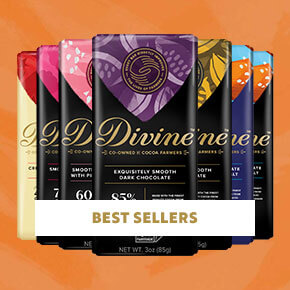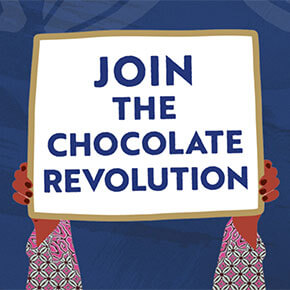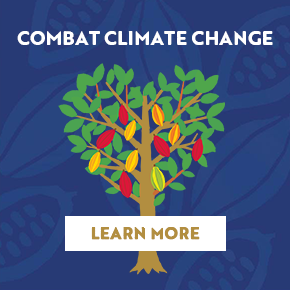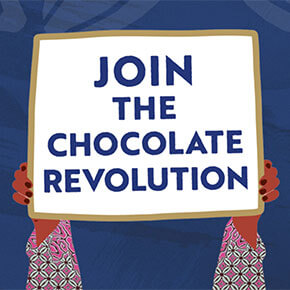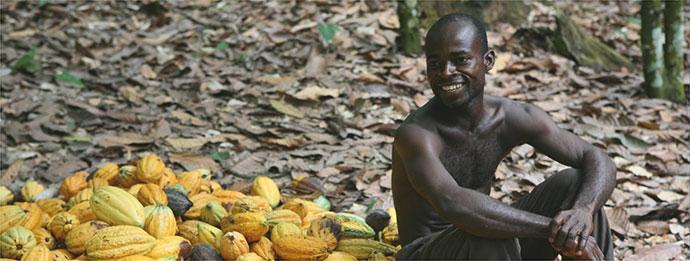Britons munched their way through over £37.5m worth of Fairtrade chocolate in 2008 (Source: The Independent, 12 October 2010).
COCOA CULTIVATION
- Chocolate is actually made from a fruit – the cocoa bean. About 40 cocoa beans are contained within a cocoa pod.
- In Ghana cocoa trees are cultivated on small farms in amongst other rainforest crops such as maize and bananas. The rainforest canopy and other plants protect the cocoa tree, providing shade from the intense Ghanaian sun.
- A cocoa tree will produce two harvests per year of about 50 pods. When a cocoa pod is ripe it will turn red, yellow or orange. Each pod contains about 40 almond-sized seeds – enough to make about eight bars of milk chocolate or four bars of dark chocolate. (Source: The BitterSweet World of Chocolate)
- Cocoa can live for up to 200 years, but only produces viable cocoa beans for 25 years.
- The Latin name for the cocoa tree is Theobroma Cacao which means ‘Food of the Gods’. The Swedish botanist Linnaeus gave the cocoa tree this name in the eighteenth century and it demonstrates how revered the tree has always been.
- West Africa has been the centre of world cocoa cultivation for over 60 years and today produces 70% of the world’s cocoa. (Source: ICCO 2012) The four major cocoa produces in West Africa are the Ivory Coast, Ghana, Nigeria and Cameroon.
- Ghana produces 25% of the world’s cocoa (Source: Worldcocoafoundation.org).
- 90% of the world’s cocoa production comes from smallholder farms (source: fairtrade.org.uk)
- Ghana is the world’s second biggest cocoa producing country. The Ivory Coast is the world’s largest producer.
- Did you know that playing music attracts snakes? So it is not a good idea for farmers to take a radio with them whilst harvesting their crop of cocoa!
- Cocoa is very prone to diseases like Black Pod and Mirid
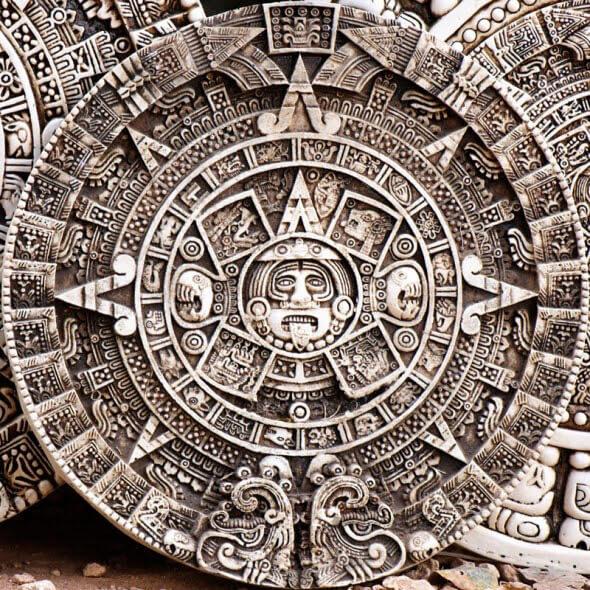
By Ancient People from the Land of Aztec (Ancient Aztec Stone Compass) [Public domain], via Wikimedia Commons
HISTORY OF CHOCOLATE
- The Olmecs of Mexico were the first civilisation to use the cocoa beans which grew wild in Central America as far back as 1500BC. That’s over 3,500 years ago!
- The Mayans were the first real chocolate lovers. They roasted and ground the cocoa beans, then mixed in vanilla, chilli and spices to make a cold bitter drink with the consistency of gruel. It tasted nothing like the hot chocolate drink that we so love today.
- The Eden Project suggest this as the old recipe for hot chocolate: Chcolatl.Cacao nibs (or unsweetened cocoa powder), maize, star anise, cloves, chilli powder, cinnamon, vanilla, annatto
- Later the Aztecs used the drink as part of their religious ceremonies. They believed that anyone who ate cocoa beans would be blessed with spiritual wisdom, energy and enhanced sexual powers. The Aztec Emperor Montezuma reportedly drank fifty cups of chocolate each day. He said, “The divine drink which builds up resistance and fights fatigue. A cup of this precious drink permits a man to walk for a whole day without food”. Chocolate truly has divine roots!
- The Aztecs loved and valued the cacao bean so highly that they used it as currency during the height of their civilisation.
- Cocoa beans were brought back to Spain in the sixteenth century. It remained the preserve of royalty and the aristocracy well into the eighteenth century and was drunk in bed at breakfast time.
- Chocolate houses sprang up in London in the seventeenth century and were frequented by the upper classes. By 1700 there were 2,000 in London. Samuel Pepys referred to a visit he took to a chocolate house: “went out with Mr Creed to drink our morning draught, which he did give me in chocolate to settle my stomach”.
- It has only been in the last 200 years that chocolate turned into the chocolate bars that fill our shelves today.
- A number of the big names in chocolate today (Cadburys, Fry’s, Terry’s, Rowntree’s) were founded with money from Quaker families who were keen for chocolate to take the place of alcohol. They saw the consumption of alcohol as a sin, whereas chocolate consumption was merely a minor vice.
- Fuelled by their desire for its delicious taste, the rulers of Europe established plantations in other equatorial countries where the cocoa tree thrives.

GHANA
- In 1879 a Ghanaian man named Tetteh Quarshie brought a few cocoa seedlings he retrieved from Fernando Po in Equatorial Guinea back home to Ghana which he planted on his farm in the small town of Mampong. The conditions proved ideal for growing cocoa, and his crop was exported from the country two years later. This marked the beginning of a revolution in Ghana’s national economy.
- By 1911 Ghana was the world’s largest cocoa producer and remains the world’s second largest producer to this day. You can visit Tetteh Quarshie’s farm and see Ghana’s first cocoa plant – it’s still alive 130 years later!
- Cocoa is Ghana’s most important agricultural earner today.
CLAIMS MADE ABOUT THE POWERS OF CHOCOLATE
- The Aztecs were the first to purport that cocoa had aphrodisiac properties and for this reason all foods made with cocoa were forbidden to women! In the seventeenth century an Austrian professor tried to ban the drinking of chocolate in monasteries because it ‘inflamed passions’.
- When the Spanish conquered South American Aztec lands they discovered the Aztec’s special drink and found that a draught of chocolate could sustain them for a whole day’s hard marching.
- Chocolate contains over 300 chemicals including a multitude of vitamins, minerals (calcium, iron, potassium, magnesium).
- Fall in love with Divine: Chocolate contains a chemical called phenylethylamine which is released naturally in the body when you fall in love and is also considered to be an aphrodisiac.
- Even the smell of chocolate causes relaxation: it significantly reduces theta activity in the brain which is associated with relaxation (Source: International Journal of Psychophysiology, 1998).
- A cup of cocoa (using pure cocoa powder) has double the amount of antioxidants as green tea (Source: Journal of Agriculture and Food Chemistry, 2003).
- Chocolate also contains dopamine which is a natural painkiller. Serotonin which is found in chocolate produces feelings of pleasure. Chocolate has over 400 distinct smells. A rose has only fourteen and an onion just six or seven.
- What is happiness? Brits prefer a chocolate bar to an extravagant holiday abroad. It’s the small things that make us happy, a survey reveals. A small gift such as chocolate was in the top five of the Happy Poll carried out by the Happy Egg Company (Source: Happy Egg Company poll, 29 Oct 2009).
CHOCOLATE INDUSTRY TODAY
- The UK has the seventh highest consumption of chocolate in the world and the 4th biggest in Europe. The average Brit consumed 8.4kg of chocolate in 2017 (Source: Mintel). Switzerland takes the top spot. 40% of the chocolate eaten in the world is consumed in Europe.
- 66% of chocolate is consumed between meals with 22% of all chocolate consumed between 8pm and midnight (Source: The World Atlas of Chocolate).
- Britain really is a nation of chocolate lovers. In Britain we eat an estimated 660,900 tonnes of chocolate a year, an average of 11kg per person per year. This equates to about 3 bars a week.
- The UK chocolate industry is worth £3.96billion (Source: Mintel 2012) and sales of chocolate just keep growing and growing, with an estimated 35% increase in sales over the next five years.
- 8,000 new chocolate products were introduced worldwide in 2008 – meaning that a new chocolate treat was launched almost every hour of every day in 2008 (Source: Mintel Global New Products Database, February 2009).
- In two years (2005 – 2007) sales of chocolate doubled in the UK. And the biggest growth was in dark chocolate. Sales in 2007 reached £85m (Source: Mintel, April 2010).
- Easter chocolate production increased by 23% in 2017
- Production of chocolate bites increased by 50% and Chocolate thins by 48% (Source: Mintel)
- 73% of chocolate consumers in the UK prefer plain chocolate.
- Nearly 7.7 million tonnes of chocolate will be consumed worldwide by the end of 2019 (Statista)
- A quarter of British people between the ages of 25 – 34 eat chocolate daily.
- It takes two to four days to make a single-serving chocolate bar.
UNUSUAL USES
- Savoury dishes. Molé is ubiquitous with Mexico – it’s a traditional sauce for chicken, turkey or beef. Added to the tomatoes, chilli, onions and spices is a small amount of dark chocolate and this creates a really rich sauce. You can add a square or two of Divine’s 70% or 85% chocolate (or Divine cocoa) to lots of savoury stews and sauces to add an extra flavour dimension and to make them really rich and glossy.
- Have you ever heard of chocolate art? Take a look at some of these incredible chocolate creations: www.foodisart.co.uk. Try your own on a smaller scale by using a brush to paint melted chocolate over a rose leaf (holding it by the stem), letting it dry, then carefully peeling off – fantastic decorations to cakes and puds!
- Did you know you can pair chocolate with wine and even tea? Take a look at Divine’s tasting notes.
- If you’re still not satiated then have a read of these chocolate classics: Charlie & the Chocolate Factory (Roald Dahl, 1964), Chocolat: A Novel (Joanne Harris, 1990), Like Water for chocolate (Laura Esquivel, 1995)
FAIRTRADE
- The Fairtrade cocoa price is a minimum of $2400 per tonne + $240 social premium per tonne.
- There are now more than 480 Fairtrade chocolate products available to purchase in the UK (Source: The Independent, 12 October 2010).
- Britons munched their way through over £37.5m worth of Fairtrade chocolate in 2008 (Source: The Independent, 12 October 2010).
- 78% of people in the UK now recognise the Fairtrade mark and sales of Fairtrade products totalled £1.57 billion in 2012 (Source: Fairtrade Foundation).
MISCELLANEOUS
- Fine chocolate does not have to mean a bar made with 70% plus cocoa solids. Quality depends on factors like the variety of beans, where they are grown, fermentation process, drying process, and the manufacturer’s recipe & methods.
- Chocolate features in Mozart’s opera Cosi Fan Tutte where a maid enters a chocolate shop carrying a chocolate pot and cups and is eventually tempted to taste it.
- In the 18th and 19th centuries it was common practice for corrupt persons to use brick dust and red lead in place of cocoa when making chocolate!
- Store your chocolate at room temperature, not in the fridge. Keep it away from direct sunlight and from changes in temperature or it will turn white-grey (this is known as blooming). White chocolate is especially vulnerable to picking up foreign flavours, so keep it away from pungent foods.
- Is it spelled cocoa or cacao? Reputedly the Victorians couldn’t pronounce cacao and so renamed it cocoa.
- Chocolate was included in soldiers’ ration packs in World War I.
QUOTES
- "What you see before you, my friend, is the result of a lifetime of chocolate." Katherine Hepburn
- "What use are cartridges in battle? I always carry chocolate instead." GeorgeBernard Shaw (British playwright and critic)
- "If you are not feeling well, if you have not slept, chocolate will revive you. But you have no chocolate! I think of that again and again! My dear, how will you ever manage?" Marquise de Sévigné (French writer and lady of fashion) February 11, 1677
- "Chocolate is the greatest gift to women ever created, next to the likes of Paul Newman and Gene Kelly. It's something that should be had on a daily basis." Sandra Bullock
- "[Chocolate is a] divine drink which builds up resistance and fights fatigue. A cup of this precious drink permits a man to walk for a while day without food." Hernan Cortes
- "The superiority of chocolate, both for health and nourishment, will soon give it the same preference over tea and coffee in America which it has in Spain." Thomas Jefferson
- "Oh, divine chocolate! They grind thee kneeling, Beat thee with hands praying, And drink thee with eyes to heaven." Marco Antonio Orellana (18th century)
- "Chocolate is a divine, celestial drink, the sweat of the stars, the vital seed, divine nectar, the drink of the gods, panacea and universal medicine." Geronimo Piperni (1796) quoted by Antonio Lavedán, Spanish army surgeon, 1796
- "There is a kind of alchemy in the transformation of base chocolate into this wise fool’s gold." Joanne Harris, Chocolat
- "If any man has drunk a little too deeply from the cup of physical pleasure; if he has spent too much time at his desk that should have been spent asleep; if his fine spirits have become temporarily dulled; if he finds the air too damp, the minutes too slow, and the atmosphere too heavy to withstand; if he is obsessed by a fixed idea which bars him from any freedom of thought: if he is any of these poor creatures, we say, let him be given a good pint of amber-flavored chocolate... and marvels will be performed." Jean Anthelme Brillat-Savarin, 1775-1826, author of ‘Physiologie du gout’ – ‘The Physiology of Taste’, one of the most celebrated works on food
- "Waked in the morning with my head in a sad taking through the last night’s drink, which I am very sorry for; so rose and went out with Mr Creed to drink our morning draft, which he did give me in chocolate to settle my stomach." From the Diary of Samuel Pepys, 17th century


